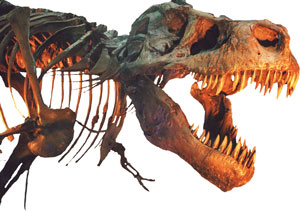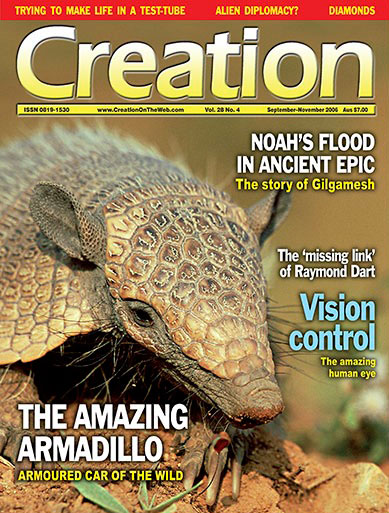Focus: creation news and views
Speciation yes, evolution no

The Australian newspaper headline proclaimed ‘Evolution simulated in the lab’. This referred to a study in the prestigious journal Nature which had recreated the double-striped South American butterfly Heliconius heurippa. They were seeking to ‘recreate the evolutionary pathway’ that had supposedly formed it. Team leader Mauricio Linares, of the University of the Andes, Colombia, has been researching this for 15 years.

Researchers had suspected that H. heurippa might be a hybrid of Heliconius cydno, which has a yellow stripe, and Heliconius melpomene, which has a red one. So the researchers interbred these two species, ‘creating a butterfly with the two-stripe pattern of H. heurippa within just three generations.’ And there was no need to physically separate the two-stripe butterflies from the others to maintain the ‘purity’ of the newly bred H. heurippa. ‘Butterflies tend to choose partners that look like themselves’, said one of the researchers, Chris Jiggins of Edinburgh University. ‘So, once the new pattern was established, these individuals have tended to mate with one another and shunned their parental species.’

This is a fantastic example of rapid speciation—no surprise to creationists (see creation.com/speedy). However, it is not evolution, as no new genetic information has been produced. The butterflies are still butterflies, with the hybrid species simply having an assortment of genes inherited from the two parent species. Both single-striped species arose—by loss of information—from an original created kind which had the information for both types of stripes.
The Australian, 16 June 2006, p. 9.
Nature 441(7095):868–871, 15 June 2006.

Get ’em young
Under the headline ‘Amen to that’, New Scientist reports that British schoolchildren from the age of 8 will be ‘taught to understand the differing claims of science and religion, including the debate between evolutionists and creationists’.
And what exactly will be taught? Perusing the website of the Oxford-based Science and Religion in Schools Project (www.srsp.net) shows that ‘big bang’ and millions-of-years ideas will be taught as fact, and that there’s nothing in the way of any challenge to the evolutionary order of appearance of organisms on earth.
Little wonder that the strongly secular pro-evolution New Scientist can say ‘Amen to that’. (See ‘The Skeptics and their “Churchian” allies’ at <creation.com/iscast>.)
New Scientist 190(2554):5, 3 June 2006.

Chimps aren’t human
When researchers from the Max Planck Institute for Evolutionary Anthropology set up an experiment to determine levels of altruism and spite in (what they say is) ‘our close cousin, the chimpanzee’, they were in for a surprise.
Contrary to expectations, the chimps’ behaviour was neither altruistic nor spiteful. The researchers say therefore that both altruism and spitefulness seem to be human-specific. They conclude that these characteristics must have evolved ‘in the last six million years since humans and chimpanzees shared a common ancestor’, and that this was probably a factor in the development of ‘the morality that defines today’s society’.
Actually, if there are moral laws, then there must be a moral law-giver. The Bible explains who this Moral Lawgiver is (Romans 2), and why humans are so different from chimps and all the other animals. We do not share a common ancestry with chimps, but we are made in the image of the Moral Lawgiver, and it wasn’t millions of years ago!
PHYSORG.COM, www.physorg.com/news9988.html, 23 June 2006.
‘Da Vinci Code’ believers

According to a survey conducted in France earlier this year, a quarter of French adults believe Dan Brown’s The Da Vinci Code is based on facts surrounding the life of Christ.
Taken just before the release of the movie, the survey reported 24% of respondents believed Brown’s Code was ‘inspired by real facts’ and another 7% said his book was a mixture of inspiration from facts and from ‘esoteric’ literary sources.
Our article in the June issue (Creation 28(3):12–17) highlighted the many historical errors in the novel. And despite Brown’s disclaimer/warning that his book is a work of fiction, the French survey results confirm what many in the church feared—that many people would believe the Code’s historical distortions.
Across the western world, many pastors and churches, recognizing the threat posed by Brown’s rewriting of history, have initiated education campaigns, public outreach programs and sermon series specifically to counter The Da Vinci Code. (See ‘The church is mobilizing!’ at <creation.com/vincijob>.)
It is completely understandable, and laudable, that the church should rally in this way against such an attack on the Bible’s authenticity and account of history.
But ironically, this passionate counter-offensive has been prompted by a work of acknowledged fiction, yet evolutionary theory and millions-of-years ideas, claimed to be fact, are also an attack on the Bible’s authenticity and account of history, but many Christians have been silent. Even worse, many have even supported long ages/evolution.
Incidentally, some of the historical errors in Brown’s book have been left out of the movie, but not his attacks on the Bible and on the divinity of Jesus Christ—see Russell Grigg’s film review at creation.com/vincimovie.
PHYSORG.COM, <www.physorg.com/news66381740.html>, 13 June 2006.
‘Schweitzer’s Dangerous Discovery’

That’s the title of an article in Discover magazine about Dr Mary Schweitzer’s discoveries of fresh dinosaur tissue (which we’ve earlier reported on—Creation 16(1):9, 1993; 19(4):42–43; 1997; 27(4):7, 2005).
Why ‘dangerous’? A sub-heading (our emphasis in bold font) explains: ‘When this shy paleontologist found soft, fresh-looking tissue inside a T. rex femur, she erased a line between past and present. Then all hell broke loose.’
The ‘line’ referred to is the supposed 65 million years that dinosaurs are reputed to have been extinct. The Discover article described how the fresh dino tissue had ‘electrified’ creationists, ‘who interpret Schweitzer’s findings as evidence that Earth is not nearly as old as scientists claim. “I invite the reader to step back and contemplate the obvious,” wrote Carl Wieland [founder of this magazine—cf. creation.com/squishosaur] last year. “This discovery gives immensely powerful support to the proposition that dinosaur fossils are not millions of years old at all, but were mostly fossilized under catastrophic conditions a few thousand years ago at most.”’
The Discover article went on to document the unwillingness of many in the scientific community to believe the findings. Even to the point that Dr Schweitzer ‘was having a hard time’ trying to get her work published in scientific journals.
‘I had one reviewer tell me that he didn’t care what the data said, he knew that what I was finding wasn’t possible,’ says Schweitzer. ‘I wrote back and said, “Well, what data would convince you?” And he said, “None.”’
Schweitzer can understand why so many are sceptical. ‘If you take a blood sample, and you stick it on a shelf, you have nothing recognizable in about a week,’ she says, adding, ‘So why would there be anything left in dinosaurs?’

Why indeed. Unless of course they haven’t been extinct for millions of years, and their remains were preserved quickly by an unusual event!
Schweitzer says of the moment she found these blood cells in the 1990s:
‘I just got goose bumps, because everyone knows these things don’t last for 65 million years.’
Schweitzer recounts how, after that first discovery, she noticed that a T. rex skeleton (from Hell Creek, Montana) had a distinctly cadaverous odour. When she mentioned this to long-time paleontologist Jack Horner, he said ‘Oh yeah, all Hell Creek bones smell.’
Consider: so ingrained is the notion among paleontologists that dinosaur bones must be millions of years old that the ‘smell of death’ didn’t even register with them—despite the evidence being right under their noses.
Discover 27(4):37–41, 77, April 2006; for our further commentary, see creation.com/schweit.
Sunny surprise

If the sun is supposed to have condensed from a cloud of dust and gas along with the planets, one would expect its makeup to be consistent with that. But new findings have cast this idea into confusion.
Researchers now report that the oxygen-16 isotope composition of the sun is dramatically lower than evolutionary cosmology predicted. Admitting this result was ‘completely unexpected’, Trevor Ireland of the Australian National University added: ‘Our sun is not the sun we thought it was.’
Thus evolutionists are left with this conundrum: how could the sun somehow end up being of a different composition from the cloud of dust and gas that is supposed to have formed it?
The facts about the sun and moon, as opposed to the continual evolutionary ‘spin’ with which they are interpreted, give no reason to doubt the biblical statement that the sun and moon were created in much their present form on the 4th Day of Creation Week, some 6,000 years ago.
ABC News Online, www.abc.net.au/news/newsitems/200604/s1610398.htm, 7 April 2006.
Nature 440(7085):776–778, 6 April 2006.
‘James’ genuine

The saga over allegations that the now-famous James ossuary inscription ‘James, son of Joseph, brother of Jesus’ (Creation 25(2):16–18, 2003) was a forgery (Creation 25(4):7, 2003; 26(2):15, 2004) has taken a dramatic new turn.
A well-known expert in geology, geochemistry and microbiology, Professor Wolfgang Krumbein of Oldenburg University (Germany), has examined the ossuary and affirmed the authenticity of the inscription. He wrote in a detailed report, containing multiple photographs (example pictured), that ‘we must conclude that the patina [incrustation that builds up over time] formed over the entire ossuary and the remains of patina in the inscription area were formed over the same period of time.’
The Biblical Archaeology Society notes that even as Israeli antiquities collector Oded Golan (accused of forging the inscription) is being tried in a criminal court, Krumbein’s report ‘may blow the case out of the water’.
On examining the ossuary in 2005, Krumbein compared it with photographs taken in 2002 which were published in the Biblical Archaeology Review and with photographs taken in 2003 by the Israel Antiquities Authority (IAA). Noting the progressive interference with the inscription patina that occurred over that period, Krumbein observes: ‘This could be taken as a documentation of deliberate manipulation of the inscription patina by the IAA and/or police during the custody period.’
Biblical Archaeology Society, www.bib-arch.org/bswbOOossuary_krumbeinsummary.asp, 19 June 2006.
Crustacean ‘living fossil’
Yet another ‘living fossil’ has been discovered, this time 400 metres under water in the Coral Sea, between New Caledonia and Australia.
Neoglyphea neocaledonica has been described as ‘halfway between a shrimp and a mud lobster’. It had been thought to have become extinct 60 million years ago.
Such discoveries are no surprise to creationists, who recognise the connection between fossils and the Flood of Noah’s day (only around 4,500 years ago)—the ‘millions of years’ of evolutionary history do not exist. See ‘“Living fossils” enigma’ at <creationon theweb.com/enigma>.
MSNBC.com, www.msnbc.msn.com/id/12875772, 26 May 2006.
Stromatolite fight

Since researchers first reported finding fossil evidence of microbial life in stromatolite rock formations in the Pilbara region of Western Australia (Creation 21(3):8, 1999), debate has raged as to whether the finely laminated dome structures might have been formed by non-living chemical processes, rather than by microbes.
This is because those rocks were dated at 3.43 billion years, which not only would make the microbes (by evolutionary reckoning) the oldest life on Earth (‘dated’ at 4.5 billion years), but it lessens the theoretical time available for life to have evolved before then.
However, recent research is reported to have confirmed ‘once and for all’ a biological origin for the stromatolites. What’s more: ‘We’re seeing evidence not just of life’s existence,’ said researcher Abigail Allwood, ‘but that it was probably well established and already biodiverse, which suggests it could have emerged much earlier in Earth’s history.’
Unwilling to accept these new findings is Professor Martin Brasier, a paleobiologist at the University of Oxford. He has long argued against the idea that the stromatolites are of biogenetic origin. ‘Much caution is needed when making claims about the earliest signs of life,’ he said. ‘In rocks of this great age we must assume the hypothesis of a non-biological origin.’
Note that it’s not because of the evidence that he rules out a biological origin, but the assumed ‘great age’—i.e. the rocks are presumed to be older than life itself, therefore any evidence to the contrary is automatically dismissed.
Nature 441(7094):714–718, 8 June 2006.
ABC Science Show, www.abc.net.au/rn/scienceshow/stories/2006/1658194.htm, 14 June 2006.
ABC News Online, www.abc.net.au/news/newsitems/200606/s1658283.htm, 8 June 2006.
‘Some catastrophic event’

The ‘mass fossil graveyard’ of western Patagonia in Argentina has yielded yet another dinosaur species, Mapusaurus roseae (rather like Giganotosaurus).
Growing up to 12.5m (40 ft) long and weighing 5 tons, seven animals of this species were uncovered, all in one deposit, and all bones there being of this species.
‘The chances they had been deposited randomly are extremely low’, says paleontologist Rodolfo Coria, who discovered the new species. National Geographic reports him as saying that ‘the skeletons showed no sign of disease, so the animals were apparently victims of some catastrophic event’.
It must, indeed, have been quite some catastrophic event to have buried suddenly a group of such large, heavy monsters. And, not just in western Patagonia, but all around the world, too, given the world-wide distribution of similarly-buried once-living creatures.
The Bible (Genesis 6–9, Luke 17:26–27, 1 Peter 3:20, 2 Peter 3:5–6) describes just such an event.
National Geographic News, news.nationalgeographic.com/news/2006/04/0417_060417_large_dino.html, 9 June 2006.
Geodiversitas 28(1):71–118, 2006.
UK call for ‘non-voluntary euthanasia’
Writing in the Royal Society of Medicine journal Clinical Ethics, Len Doyal, an emeritus professor of medical ethics and adviser to the British Medical Association, has firmly backed non-voluntary euthanasia for patients who are too ill to ask for death.
Doyal contends that ‘regulated, intentional active killing can have a proper place in good medical practice’, and asks: ‘What would be the moral point in expending [valuable palliative care] resources on severely incompetent patients whose best interests will be served by a quick and painless death?’
One can find the answer to Doyal’s ‘moral point’ challenge in the Bible—i.e. we should acknowledge the Creator as the giver and taker of life.
Our lives are not our own (Jeremiah 10:23) but belong to God (1 Corinthians 6:20), who said ‘you shall not murder’ (Exodus 20:13).
However, for those who believe evolution rather than the Bible’s Creation account, euthanasia (whether ‘voluntary’ or otherwise) makes economic sense.
And, with British public institutions having taught the evolutionary theory of origins for many years, it’s not surprising that views like Doyal’s are becoming more common.
British opponents of ‘assisted dying’ are justifiably concerned, especially having now observed the consequences of the Dutch legalization of euthanasia. Peter Saunders, campaign director of the anti-euthanasia alliance Care Not Killing, said: ‘The clear lesson from the Netherlands, where over 1,000 patients are killed by doctors every year without their consent and where babies with special needs are killed … is that when voluntary euthanasia is legalised involuntary euthanasia inevitably follows.’
The Guardian, www.guardian.co.uk/frontpage/story/0,,1792711,00.html, 14 June 2006.
BioEdge, www.australasianbioethics.org/Newsletters/207-2006-06-13.html, 14 June 2006.

Mt St Helens’ speedy slab
Many people think rocks take millions of years to form. This huge slab at Mt St Helens demonstrates otherwise. It began growing late last year. When this photo was taken just a few months later, the rock slab jutted about 100 metres out from one of the volcano’s craters, and was continuing to grow at more than one metre per day.
National Geographic News, news.nationalgeographic.com/news/2006/05/060509_st-helens.html, 14 June 2006.
Edomite copper confounds critics

When archaeologists announce the discovery of evidence that is seen as confirming the reliability of the Bible’s historical account, it often ignites controversy.
A heated debate has erupted over the findings of Thomas Levy, an archaeologist at the University of California, and Mohammad Najjar of the Department of Antiquities of Jordan.
They say their excavations, e.g. at the ruins of a large copper-processing centre and fortress at Khirbat en-Nahas, in the lowlands of what was Edom and is now part of Jordan, show that Edom may indeed have been a cohesive and complex state as early as the 12th century BC, and certainly by the 10th. This is consistent with the Bible’s account of Edom being an implacable adversary and menacing neighbour of the Israelites, who dealt with them by force under the leadership of kings like David and Solomon.
However, this contrasts starkly with the claims of ‘liberal’ critics who contend that in David’s time (10th century BC), the nomadic tribes of Edom had not become an organized society with the might to threaten the Israelites. Moreover, according to this ‘low chronology’ or ‘minimalist’ view of biblical history, ancient Israel did not develop into a true state until the eighth century BC, a century and a half after David.
Nevertheless Levy and Najjar argue that they have dated the Edomite ruins accurately, and that ‘only a complex society’ such as a paramount chiefdom or kingdom would have had ‘the organizational know-how to produce copper metal on such an industrial scale.’ In the Biblical Archaeology Review, they wrote that ‘the biblical references to the Edomites, especially their conflicts with David and subsequent Judahite kings, garner a new plausibility.’
The New York Times, 13 June 2006, p. F1.


Readers’ comments
Comments are automatically closed 14 days after publication.